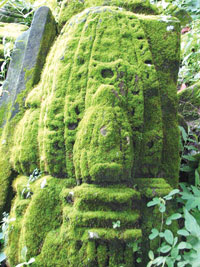 It's quiet, serene and green. Thousands of intricately carved stones of various sizes litter the ruins at Kankre Bihar on Surkhet's Latikoili hill. Huge moss-covered plinth stones with floral and geometric patterns lean on smaller stones carved with idols of various deities, including the Buddha.
It's quiet, serene and green. Thousands of intricately carved stones of various sizes litter the ruins at Kankre Bihar on Surkhet's Latikoili hill. Huge moss-covered plinth stones with floral and geometric patterns lean on smaller stones carved with idols of various deities, including the Buddha.
Prayer flags strung across trees flutter in the early morning breeze, thick vines swing across the tall sal. There is a sense of timelessness here amidst these ancient stones scattered in the lush undergrowth.
 Who built this temple complex? Where did this civilization vanish? What did Surkhet Valley look like then? Locals believe the ruins date back to the stories of Hindu mythology. "We grew up hearing that this was built by the Pandavas during their long exile," says Sher Bahadur Karki, caretaker of the Kankre Bihar, "and they used to travel across the lake to go to Patal Ganga for daily rituals." Indeed, there is geological proof that Surkhet Valley used to be a huge lake. And just like Manjushree is supposed to have drained Kathmandu's lake, locals believe Bhim drained Surkhet with his spade.
Who built this temple complex? Where did this civilization vanish? What did Surkhet Valley look like then? Locals believe the ruins date back to the stories of Hindu mythology. "We grew up hearing that this was built by the Pandavas during their long exile," says Sher Bahadur Karki, caretaker of the Kankre Bihar, "and they used to travel across the lake to go to Patal Ganga for daily rituals." Indeed, there is geological proof that Surkhet Valley used to be a huge lake. And just like Manjushree is supposed to have drained Kathmandu's lake, locals believe Bhim drained Surkhet with his spade.
Archaeologists who started excavating the site in 2005, however, say the ruins date back to the Khasa Malla rulers of midwestern Nepal 800 years ago, and were probably destroyed by invaders. The archeologists took two years to catalogue more than 2,000 stones, then the budget ran out and the work stopped. Today, picnickers have scrawled graffiti and etched initials on the scattered stones.
 "I try my best to protect this place, but how much can one person do?" says Karki, 56, who is allowed to take his salary from the entrance fee and earns up to Rs 2,500 a month. During the height of the conflict, he had no income.
"I try my best to protect this place, but how much can one person do?" says Karki, 56, who is allowed to take his salary from the entrance fee and earns up to Rs 2,500 a month. During the height of the conflict, he had no income.
"During the war there were few visitors and even those who came didn't ask any questions," Karki recalls.
The mandala-shaped bihar has been restored up to plinth level and the steps leading up to it have been restored. Missing stones have been replaced with new ones, but even these are now covered with moss.
Karki has heard the government allocated Rs 1.5 million this year for restoration, but says he'll believe it when he sees it. So Kankre Bihar waits. Restoration will probably bring tourists and visitors from Surkhet and beyond. But walking down the hill from Latikoili, one wishes the ancient monastery is left as it is in its ageless serenity and solitude.
Rupa Joshi


